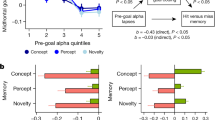Abstract
Subjects were classified according to whether they were high or low in the need for Power and high or low in gain in 3-methoxy-4-hydroxyphenylglycol (MHPG), a putative index of brain norepinephrine (NE) turnover, after engaging in some tasks that involved memory for story content. Subjects who were high inn Power and in the index of brain NE turnover showed better recall of power-related facts than subjects low on both these characteristics, confirming an earlier finding, which suggests that the need for Power is subserved by a noradrenergic reward system in the brain.
Similar content being viewed by others
References
Cooper, J. R., Bloom, F. E., & Roth, R. H. (1982).The biochemical basis of neuropharmacology (4th ed.). New York: Oxford.
Estes, W. K. (1958). Stimulus response theory of drive. In M. R. Jones (Ed.),Nebraska symposium on motivation. Lincoln: University of Nebraska Press.
Frankenhaeuser, M. (1975). Experimental approaches to the study of the catecholamines and emotion. In L. Levi (Ed.),Emotions: Their parameters and measurement. New York: Raven.
Heyns, R., Veroff, J., & Atkinson, J. W. (1958). A scoring manual for the affiliation motive. In J. W. Atkinson (Ed.),Motives in fantasy, action and society. New York: Van Nostrand.
Hull, C. L. (1952).A behavior system. New Haven: Yale University Press.
Kandel, E. R., & Schwartz, J. H. (1982). Molecular biology of learning: Modulation of transmitter release.Science, 218 433–443.
Kopin, I. J., Gordon, E. K., Jimerson, D. C., & Polinsky, R. J. (1983). Relation between plasma and cerebrospinal fluid levels of 3-methoxy-4-hydroxyphenylglucol.Science, 219 73–75.
Maas, J. W., Hattox, S. E., Greene, N. M., & Landis, D. H. (1979). 3-methoxy-4-hydroxyphenylglycol production by human brain in vivo.Science, 205 1025–1027.
McAdams, D. P. (1980). A thematic coding system for the intimacy motive.Journal of Research in Personality, 14 413–432.
McAdams, D. P., & McClelland, D. C. (1983).Social motives and memory. Unpublished manuscript, Harvard University.
McClelland, D. C. (1976). Sources of stress in the drive for power. In G. Serban (Ed.),Psychopathology of human adaptation. New York: Plenum.
McClelland, D. C. (1984).Human motivation. Glenview, Illinois: Scott, Foresman.
McClelland, D. C., Davidson, R. J., Floor, E., & Saron, C. (1980). Stressed power motivation, sympathetic activation, immune function and illness.Journal of Human Stress, 6(2), 11–19.
McClelland, D. C., Davidson, R., Saron, C., & Floor, E. (1980). The need for power, brain norepinephrine turnover, and learning.Biological Psychology, 10 93–102.
McClelland, D. C., & Jemmott, J. B., III. (1980). Power motivation, stress, and physical illness.Journal of Human Stress, 6(4), 6–15.
McClelland, D. C., Ross, G., & Patel, V. (in press). The effect of an academic examination on salivary norepinephrine and immunoglobulin levels.Journal of Human Stress.
McEntee, W. J., & Mair, R. G. (1978). Memory impairment in Korsakoff's psychosis: A correlation with brain noradrenergic activity.Science, 202 905–907.
Phillips, A. G., Carter, D. A., & Fibiger, H. C. (1976). Differential effects of parachlorophenylalanine on self-stimulation in caudate-putamen and lateral hypothalamus.Psychopharmacology, 49 23–37.
Stein, L. (1974). Norepinephrine reward pathways: Role in self-stimulation, memory consolidation and schizophrenia. In J. K. Cole & T. B. Sonderreger (Eds.),Nebraska symposium on motivation. Lincoln: University of Nebraska Press.
Stinus, L., Thierry, A.-M., Blanc, G., Glowinski, J., & Cardo, B. (1973). Self-stimulation and catecholamines. III. Effect of imposed or self-stimulation in the area ventralis tegmenti on catecholamine utilization in the rat brain.Brain Research, 64 199–210.
Winter, D. G. (1973).The power motive. New York: Free Press.
Wise, R. A. (1980). Actions of drugs of abuse on brain reward systems.Pharmacology, Biochemistry, and Behavior, 13 (Supplement 1), 213–223.
Author information
Authors and Affiliations
Rights and permissions
About this article
Cite this article
McClelland, D.C., Maddocks, J.A. & McAdams, D.P. The need for power, brain norepinephrine turnover, and memory. Motiv Emot 9, 1–10 (1985). https://doi.org/10.1007/BF00991546
Issue Date:
DOI: https://doi.org/10.1007/BF00991546




